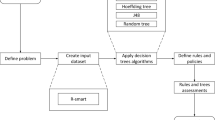Abstract
In order to remain competitive in the global market, original equipment manufacturers (OEMs) are developing a process-based, knowledge-driven product development environment with emphasis on the acquisition, storing, and utilization of manufacturing knowledge. This is usually achieved by using the symbolic artificial intelligence (AI) approach. Specifically, knowledge-based expert systems are developed to capture human expertise, mostly in terms of IF–THEN production rules. It has been recognized that the development of symbolic knowledge-based expert systems suffers from the so-called knowledge acquisition bottleneck. Knowledge acquisition is the process of collecting domain knowledge and transforming the knowledge into a computerized representation. It is a challenging and time-consuming process due to the difficulties involved in eliciting knowledge from human experts. This paper presents an automated approach for knowledge acquisition by integrating neural networks' learning ability and fuzzy logic's structured knowledge representation. Using this approach, knowledge is automatically acquired from data and represented using humanly intelligible fuzzy rules. The approach is applied to a case study of the design and manufacturing of micromachined atomizers for gas turbine engine. The influence of geometric features on the performance of the atomizers is investigated. The results are then compared with those obtained using traditional regression analysis approach (abstract mathematical models). It was found that the automated approach provides an efficient means for knowledge acquisition. Since the fuzzy rules extracted are easy to understand, they can be used to allow more clear specification of manufacturing processes and to shorten learning curves for novice manufacturing engineers.
Similar content being viewed by others
References
Badiru, A. B. (1992) Expert Systems Applications in Engineering and Manufacturing, Englewood Cliffs, NJ: Prentice Hall.
Berenji, H. R. (1991) Refinement of approximate reasoning-based controllers by reinforcement learning, Proceedings of the Eighth International Machine Learning Workshop, Evanston, IL.
Feigenbaum, E. A. (1979) Themes and case studies of knowledge engineering, in Expert Systems in the Micro-Electronic Age, D. Michie (ed.), Edinburgh University Press, Edinburgh, Scotland, pp. 3-25.
Gonzalez, A. J. and Dankel, D. D. (1993) The Engineering of Knowledge-Based Systems: Theory and Practice, Prentice Hall, Englewood Cliffs, NJ.
Halgamuge, S. K. and Glesner, M. (1994) Neural networks in designing fuzzy systems for real world application. Fuzzy Sets and Systems, 65(1), 1-12.
Horikawa, S., Furuhashi, T. and Uchikawa, Y. (1992) On fuzzy modeling using fuzzy neural networks with back-propagation algorithm. IEEE Transactions on Neural Networks, 3(5), 801-806.
Jang, J.-S. R., Sun, C.-T. and Mizutani, E. (1997) Neuro-Fuzzy and Soft Computing: A Computational Approach to Learning and Machine Intelligence, Prentice Hall, Upper Saddle River, NJ.
Kasabov, N. K. (1996) Learning fuzzy rules and approximate reasoning in fuzzy neural networks and hybrid systems. Fuzzy Sets and Systems, 82, 135-149.
Kasabov, N. K. (1998) Foundations of Neural Networks, Fuzzy Systems, and Knowledge Engineering, The MIT Press, Cambridge, MA.
Krishnan, R., Sivakumar, G. and Bhattacharya, P. (1999) A search technique for rule extraction from trained neural networks. Pattern Recognition Letters, 20, 273-280.
Lin, C. T. and Lee, C. S. G. (1996) Neural Fuzzy Systems: A Neuro-Fuzzy Synergism to Intelligent Systems, Prentice Hall, Upper Saddle River, NJ.
Masuoka, R., Watanabe, N., Kawamura, A., Owada, Y. and Asakawa, K. (1990) Neurofuzzy systems—fuzzy inference using a structured neural network. Proceedings of the International Conference on Fuzzy Logic and Neural Network, Iizuka, Japan.
Mitra, S. (1994) Fuzzy MLP based expert system for medical diagnosis. Fuzzy Sets and Systems, 65(2/3), 285-296.
Mital, A. and Anand, S. (1993) Handbook of Expert Systems Applications in Manufacturing: Structures and Rules, Chapman and Hall, New York, NY.
Nauck, D. and Rudolf, K. (1997) A neuro-fuzzy method to learn fuzzy classification rules from data. Fuzzy Sets and Systems, 89, 277-288.
Nauck, D., and Rudolf, K. (1999) Obtaining interpretable fuzzy classification rules from medical data. Artificial Intelligence in Medicine, 16, 149-169.
Nauck, D., Klawonn, F. and Kruse, R. (1997) Foundation of Neuro-Fuzzy Systems, John Wiley & Sons, New York, NY.
Optiz, D. W. and Shavlik, J. W. (1995) Dynamically adding symbolically meaningful nodes to knowledge-based neural networks. Knowledge-Based Systems, 8(6), 301-311.
Sethi, I. K. and Yoo, J. H. (1996) Symbolic mapping of neurons in feedforward networks. Pattern Recognition Letters, 17, 1035-1046.
Singh, A., Mehregany, M., Phillips, S. M., Harvey, R. J. and Benjamin, M. (1998) Micromachined silicon fuel atomizers for gas turbine engines. Atomization and Sprays, 8, 405-418.
Towell, G. (1991) Symbolic Knowledge and Neural Networks: Insertion, Refinement, and Extraction, PhD Thesis, Computer Science Department, University of Wisconsin at Madison.
Towell, G. and Shavlik, J. (1994) Knowledge-based artificial neural networks, Artificial Intelligence, 70(1/2), 119-165.
Author information
Authors and Affiliations
Rights and permissions
About this article
Cite this article
Huang, S.H., Hao, X. & Benjamin, M. Automated knowledge acquisition for design and manufacturing: The case of micromachined atomizer. Journal of Intelligent Manufacturing 12, 377–391 (2001). https://doi.org/10.1023/A:1011271501713
Issue Date:
DOI: https://doi.org/10.1023/A:1011271501713




